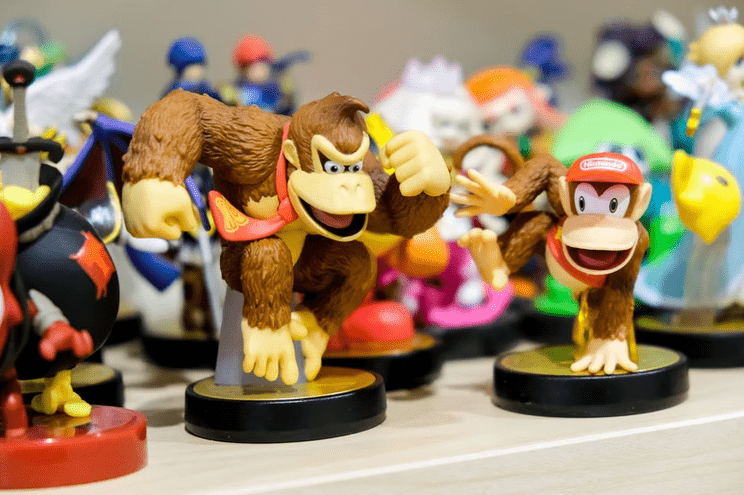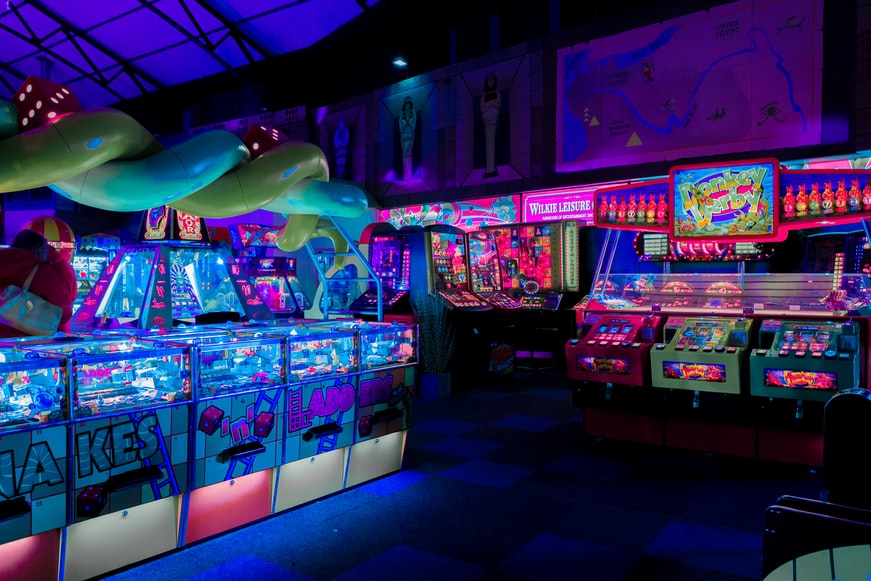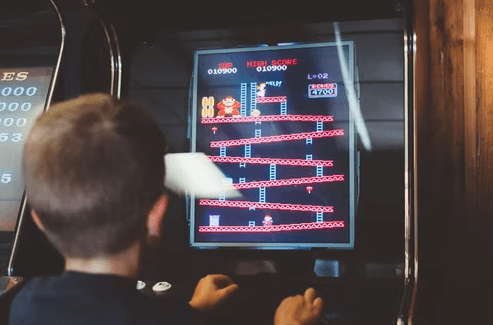It all began in the 1980s when Shigeru Miyamoto first started working for Nintendo. He had planned to produce a Popeye game, but Nintendo’s licensing agreement fell through. Jumpman (soon to be Mario) and Donkey Kong are two new characters created by Shigeru. The name Kong was inspired by the film King Kong, and according to a Japanese/English dictionary, the ‘Donkey’ element of the name means dumb.
Donkey Kong is one of Nintendo’s oldest properties, and with a new Wii U version, it’s regaining popularity. DK is, without a doubt, Nintendo’s second most well-known character. But how well do you know Donkey Kong?
He’s been in some of the most well-known video games of all time, but most casual fans are unaware of his background. What has the reactionary gorilla been up to all these years, and what are the most peculiar aspects of his ancestry?
When first we met
Nintendo had barely dipped its toe into the burgeoning Japanese game market when it decided to go to the United States in 1981. The game really became a classic 90s video game in the US. The goofy but straightforward story followed a carpenter’s pet gorilla stealing the workman’s lady, introducing a real narrative to gaming. As a result, Donkey Kong was born.
Neither Monkey Kong nor King Kong
Fans are still perplexed as to why a massive gorilla is named Donkey. It’s a frequent misconception that Donkey Kong is a mistranslation of Monkey Kong, although this has been proven false. According to inventor Shigeru Miyamoto, the name “Donkey” was chosen on purpose to reflect the ape’s obstinacy.
DK’s last name got Nintendo in difficulty with Universal Studios, regardless of where his initial name came from. The movie studio alleged that the narrative and title of the game infringed on its King Kong copyright. The huge studio thought it could bully Nintendo into settling, but Nintendo’s legal team stood firm.
The court sided with Nintendo after establishing that Universal didn’t even own the rights to King Kong. This was a significant victory for Nintendo on its way to US expansion.
Save Papa!
Donkey Kong did not return as the conquering hero in his second adventure when it was finally time for the ape’s big sequel. He’s the damsel in distress, held captive by Mario and aided by his son, the titular Donkey Kong Junior. Junior’s mother has yet to be met by gamers, but we were too preoccupied with saving Papa at the moment to notice.
As a whip-wielding jailer out to kill a newborn gorilla, Mario is unsettling these days, perhaps to play against player expectations at the time. It’s a gamble Nintendo would never take with its mascot again. In reality, after this game, Donkey Kong and his nemesis would split ways for a long time.
Forgotten Enemies
Donkey Kong’s third arcade game saw him revert to his destructive ways after being finally set free by his son. This time, the intimidating beast avoided Mario—who was reveling in his newfound success in Mario Bros—and seized control of a stranger’s greenhouse. The now-forgotten Stanley the Bugman was the only one who came to the vulnerable plants’ aid.
Donkey Kong 3 is an odd asterisk in the ape’s history, abandoning platforming in favor of a Galaga-styled shooter. Stanley is an unnecessary Mario substitute, as cool as he is. However, I do like the little dance he makes after winning. Looking back, players experienced a peculiar mood swing throughout this period. They were now expected to shoot DK in the crotch with the bug spray after pitying him in the second game.
In Country
Following DK3, Kong’s appearances were primarily limited to arcade ports. At the same time, Jr. unexpectedly joined the lineup of Super Mario Kart instead of him, a move that would not be repeated in subsequent Kart titles. Then, in 1994, he made a big comeback, complete with a new red necktie.
DK was originally seen in the fantastic Game Boy version of the arcade original, where he was at his most nasty. Then, courtesy to some Northern English tech wizards, Kong got his own console series.
Enter Diddy Kong
Nintendo rejected Rare’s redesign for Donkey Kong Jr., forcing Rare to recycle the appearance for Diddy Kong, an altogether new sidekick. Throughout DKC, the tiny monkey stayed close to his elder, even in the treacherous underwater and mine cart segments, and he developed a sizable fan base of his own. Diddy had supplanted DK in the lead role by the time the sequel was released.
The Missing Link
Donkey Kong Country may have reintroduced DK to the spotlight, but it also raised a question of identity that Nintendo has yet to properly address. DKC debuted a new Kong family, including the crotchety (yet endearing) Cranky Kong. Pauline was kidnapped by an elderly monkey who claimed to be the original arcade Donkey Kong. If that’s the case, who is Donkey Kong in Donkey Kong Country, and what happened to DK Jr.?
Cranky claimed to be DK’s father and grandfather at different times when Rare was in charge of the DK mythology, although Nintendo first ignored the narrative when Donkey Kong appeared in other games. Cranky being DK’s father makes more sense because that would indicate DK is an adult version of Junior, but Cranky is explicitly designated as DK’s grandfather in his more recent Nintendo-supervised appearances.
Too much of a good thing
Rare went on to the N64 and became one of the dominant developers for the system, after dominating the sales charts in the second half of the SNES’s existence. Before returning to Donkey Kong 64, Rare used the console to introduce a slew of new characters, including Banjo-Kazooie and Jet Force Gemini.
Unfortunately, despite its high quality, the game’s formula had become stale. The actual issue with DK64, apart from the so-bad-it’s-good rap that opens the game, is that it buried players in collectibles.
Each of the five playable characters has a distinctive colored coin to collect after unlocking them, as well as Golden Bananas, Crystal Coconuts, keys, rolls of film, headphones, and medals that are scattered around each stage. Rare was known for exploiting dozens of hidden items to increase playtime, but DK64 went to such absurd lengths that many gamers panned it. Many gamers needed a break from the ape’s world after DK64.
An adventure that was never meant to be
Despite having numerous titles planned for the Nintendo GameCube, Rare’s last hurrah with the primate was Donkey Kong 64. Donkey Kong Racing, depicted above, was one of the first games displayed for GameCube and was even advertised on the system’s North American packaging.
When an unlikely corporate buyer purchased Rare, it and two other DK games were canceled.
Nintendo became a part-owner of Rare with the success of Country, but when the N64 was retired, Nintendo elected to sell its investment in Rare to Microsoft. When Microsoft hired Rare to work on games for the Xbox and its successor, Nintendo canceled several Donkey Kong games that were suddenly without a developer.
After the transaction, it was initially unclear to fans who owned which Country characters, but Nintendo finally acquired all of them. The publisher, predictably, returned the ape to the first party fold at that time. And if you want to discover the 5 Amazing Health Benefits of Playing Video Games, click the link.
Final Word
Key events from the previous 30 years are recounted in the timeline. 19 various game versions have made history in the gaming industry.Donkey Kong has never been just a video game to him. A large number of non-game players were drawn to a number of peripheral things, in addition to cartoon and comic works.
Over a hundred concerts were held throughout the world as part of the tour. We have cause to believe that work is as important to the video gaming industry as this one will shine even brighter in the future. Meanwhile, open the link to find out why you should not let your children play video games for extended hours during the lockdown.



